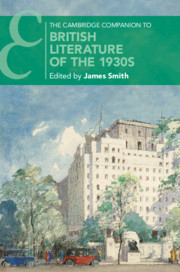Book contents
- The Cambridge Companion to British Literature of the 1930s
- The Cambridge Companion to British Literature of the 1930s
- Copyright page
- Contents
- Notes on Contributors
- Introduction
- Chapter 1 Poetry
- Chapter 2 The Literary Novel
- Chapter 3 Drama
- Chapter 4 Publishing and Periodicals
- Chapter 5 The Middlebrow and Popular
- Chapter 6 Modernism
- Chapter 7 Communism and the Working Class
- Chapter 8 Empire
- Chapter 9 Travel
- Chapter 10 The Regional and the Rural
- Chapter 11 The Queer 1930s
- Chapter 12 Remembering and Imagining War
- Chapter 13 Fascism and Anti-Fascism
- Chapter 14 Fashioning the 1930s
- Index
- Cambridge Companions to …
Chapter 5 - The Middlebrow and Popular
Published online by Cambridge University Press: 18 December 2019
- The Cambridge Companion to British Literature of the 1930s
- The Cambridge Companion to British Literature of the 1930s
- Copyright page
- Contents
- Notes on Contributors
- Introduction
- Chapter 1 Poetry
- Chapter 2 The Literary Novel
- Chapter 3 Drama
- Chapter 4 Publishing and Periodicals
- Chapter 5 The Middlebrow and Popular
- Chapter 6 Modernism
- Chapter 7 Communism and the Working Class
- Chapter 8 Empire
- Chapter 9 Travel
- Chapter 10 The Regional and the Rural
- Chapter 11 The Queer 1930s
- Chapter 12 Remembering and Imagining War
- Chapter 13 Fascism and Anti-Fascism
- Chapter 14 Fashioning the 1930s
- Index
- Cambridge Companions to …
Summary
To be classified as ‘popular’ or ‘middlebrow’ is to be damned with imprecise and, often, faint praise. This is particularly true in the 1930s when questions of literary ‘taste’ and ‘value’ increasingly shifted the parameters of critical reception in Britain by drawing distinctions between the popular and highbrow while airing the notion of the ‘middlebrow’ as a third classification. These categorisations accelerated debates about the rise in commercial writing in the period while lamenting the wider effects of mass culture on society. Fundamentally, this discussion became a struggle over ideas of cultural and intellectual authority that broadly coincided with a proliferation of novels written predominantly for a wide readership, particularly of middle-class women, under the classification ‘middlebrow’, as Nicola Humble’s groundbreaking study The Feminine Middlebrow Novel, 1920s–1950s establishes.
- Type
- Chapter
- Information
- Publisher: Cambridge University PressPrint publication year: 2019
- 13
- Cited by

